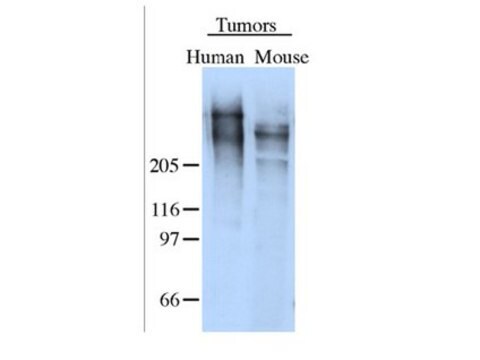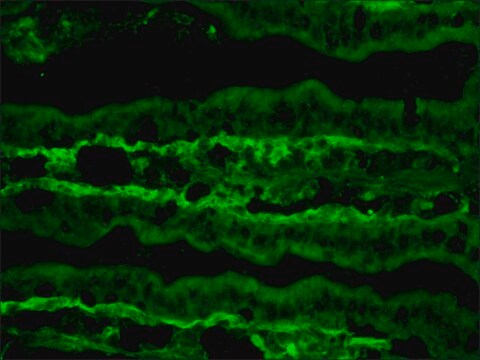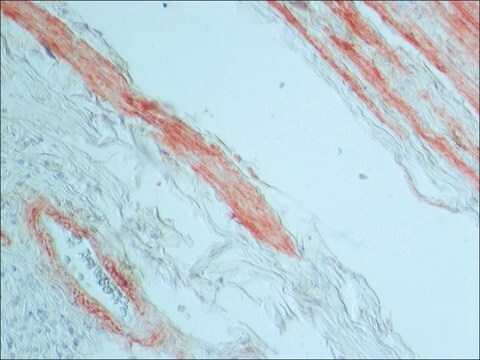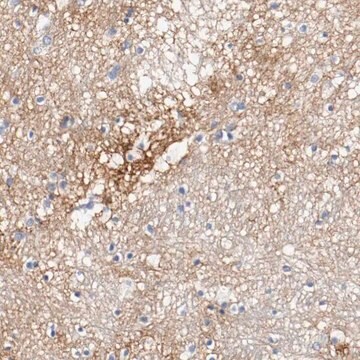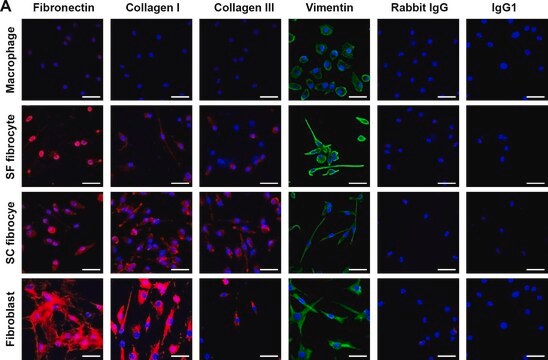SAB4200782
Anti-Tenascin antibody, Mouse monoclonal
clone BC-24, purified from hybridoma cell culture
同義詞:
Anti-Cytotactin, Anti-GMEM, Anti-GP 150-225, Anti-Glioma-associated-extracellular matrix antigen, Anti-Hexabrachion, Anti-JI, Anti-Myotendinous antigen, Anti-Neuronectin, Anti-TN, Anti-Tenascin-C (TN-C)
登入查看組織和合約定價
全部照片(1)
About This Item
分類程式碼代碼:
12352203
NACRES:
NA.41
推薦產品
生物源
mouse
品質等級
抗體表格
purified from hybridoma cell culture
抗體產品種類
primary antibodies
無性繁殖
BC-24, monoclonal
形狀
buffered aqueous solution
物種活性
human
濃度
~1.0 mg/mL
技術
ELISA: suitable
flow cytometry: suitable
immunoblotting: suitable
immunohistochemistry: 5-10 μg/mL using pronase-retrieved formalin-fixed, paraffin-embedded human tonsil sections
同型
IgG1
UniProt登錄號
運輸包裝
dry ice
儲存溫度
−20°C
目標翻譯後修改
unmodified
基因資訊
human ... TNC(3371)
一般說明
Monoclonal Anti-Tenascin (mouse IgG1 isotype) is derived from the BC-24 hybridoma, produced by the fusion of mouse myeloma cells and splenocytes from a mouse immunized with human tenascin. Tenascin-C (TN-C) is also known as Hexabrachion, Cytotactin, Neuronectin (NEC1). It is a high molecular mass extracellular matrix glycoprotein. Human tenascin is a disulfide-linked hexamer composed of 3 subunits of 190, 200, and 220 kDa.
免疫原
Human tenascin
應用
Anti-Tenascin antibody has been used:
- in immunoblotting
- in Immunohistochemistry
- in flow cytometry
- in enzyme linked immunosorbent assay(ELISA)
- for blocking tenascin-C proliferating activity
生化/生理作用
Tenascin-C (TN-C) functions in cell adhesion, fibroblast migration, and other processes related to tissue remodeling and wound healing. It has been proposed that actively growing, migrating and differentiating epithelial sheets can produce factors such as (Transforming growth factor beta) TGF-β to stimulate tenascin expression. Neo-expression or increased expression of tenascin has been found in the stroma of various tumors and during normal tissue repair. Intracytoplasmic tenascin immunoreactivity has been detected in malignant melanomas and in lung carcinomas, and it serves as a marker of stromal element proliferation in invasive breast carcinomas. High-molecular mass tenascin isoform plays a role in generating a permissive environment for proliferation, invasion, and metastasis of neoplastic epithelial cells. Human tenascin contains an Arg-Gly-Asp (RGD) sequence which may function in cell adhesion and mediates cell attachment through an RGD-dependent integrin receptor.
外觀
Solution in 0.01 M phosphate buffered saline, pH 7.4, containing 15 mM sodium azide as a preservative.
其他說明
This product is for R&D use only, not for drug, household, or other uses.
未找到適合的產品?
試用我們的產品選擇工具.
儲存類別代碼
10 - Combustible liquids
水污染物質分類(WGK)
nwg
閃點(°F)
Not applicable
閃點(°C)
Not applicable
The role of tenascin-C in tissue injury and tumorigenesis
Midwood K S, et al.
Journal of Cell Communication and Signaling, 3(3-4), 287-310 (2009)
Tenascin-C modulates tumor stroma and monocyte/macrophage recruitment but not tumor growth or metastasis in a mouse strain with spontaneous mammary cancer
Talts J F, et al.
Journal of Cell Science, 112(12), 1855-1864 (1999)
Christopher R Silvers et al.
British journal of cancer, 125(10), 1399-1407 (2021-09-27)
Markers of stromal activation at future metastatic sites may have prognostic value and may allow clinicians to identify and abolish the pre-metastatic niche to prevent metastasis. In this study, we evaluate tenascin-C as a marker of pre-metastatic niche formation in
L Borsi et al.
International journal of cancer, 52(5), 688-692 (1992-11-11)
Functionally different tenascin (TN) isoforms, containing varying numbers of a 91 amino-acid motif resembling the fibronectin type-III homology repeat, may be generated by alternative splicing of the TN primary transcript. In fact, only the TN isoform containing the alternatively spliced
Gregory S Schultz et al.
Wound repair and regeneration : official publication of the Wound Healing Society [and] the European Tissue Repair Society, 17(2), 153-162 (2009-03-27)
Dynamic interactions between growth factors and extracellular matrix (ECM) are integral to wound healing. These interactions take several forms that may be categorized as direct or indirect. The ECM can directly bind to and release certain growth factors (e.g., heparan
Global Trade Item Number
| 庫存單位 | GTIN |
|---|---|
| SAB4200782-100UL | 4061833253816 |
我們的科學家團隊在所有研究領域都有豐富的經驗,包括生命科學、材料科學、化學合成、色譜、分析等.
聯絡技術服務